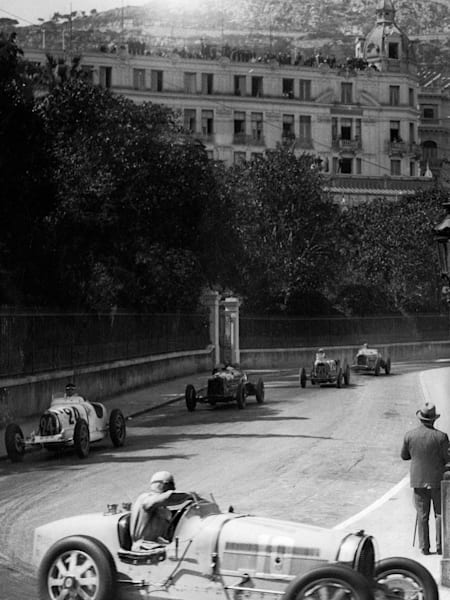In 1950 and in response to the World Motorcycling Championship started in 1949, the Fédération Internationale de l'Automobile (FIA) organized the first World Drivers’ Championship. But what was racing like before the first world championship race?
Motor racing started to take shape in France around 1884, quickly evolving from simple races from one village to another to sophisticated events. So let’s have a look at what Formula One was like before the creation of the FIA World Championship that we know today…
The first races in history
In 1900 an event that proved crucial in the racing world was held by James Gordon Bennett Jr., Owner of newspapers New York Herald and the Herald Tribune, who created the Gordon Bennett Cup in Europe, an annual race attracted international competitors from around the world and in which each country could register up to three cars.
Following the example of Bennett, millionaire William Kissam Vanderbilt II launched the Vanderbilt Cup in the United States. Specifically, in Long Island, New York, in 1904.
Influenced by these competitions, Louis Chevrolet, a Swiss man who worked for a French builder, decided to move to the United States. Since 1901 he became the leading figure of American country races and designed the vehicles of General Motors that bore his name.
The first Grand Prix
In 1906, the first race that bore the name Grand Prix was organized by the Automobile Club of France (CAF) and ran for two days in the month of June. The circuit, located in Le Mans, had a total length of around 105 kilometres (65 miles) with 32 participants, representing 12 different automakers. Hungarian Ferenc Szisz (1873-1944) at the wheel of a Renault won the race after 1,260 km.
Each country organised their own events without a formal championship to link them together, with the rules varying depending on the country.
All racers though had a mechanic on board and no one was allowed to repair or work on the car, except for them and the drivers themselves. A key factor for the success of Renault was the use of detachable wheels (developed by Michelin), which allowed the change without dismantling the car.
The circuits take shape
Most races ran on long circuits formed by public road that were temporarily closed and not on race tracks built specifically to compete on. This was the origin of the Grand Prix of Le Mans in 1906, as well as the Targa Fiorio, which ran along 150 kilometres of Sicilians roads, the German circuit Kaiserpreis (120 km) and the French circuit Dieppe (77 km), used in the Grand Prix of 1907.
The exceptions were the circuits of Brooklands in England, completed in 1907, the Indianapolis Motor Speedway, first used in 1909 and the Autodromo Nazionale Monza in Italy, opened in 1922.
That same year, Italy became the second country, after France, to host a race using the name 'Grand Prix' at Monza. The name quickly spread to Belgium and Spain in 1924, and later spread to other countries. However, it was not a formal championship, but a variety of races that were held under different rules.
Just before World War I however, various Grands Prix started sharing some rules, mainly engine sizes and weight.
In 1924 the Association Internationale des Automobile Clubs Reconnus (AIACR) formed, whose mission was unofficially regulating Grand Prix racing. However, these regulations were abandoned in 1928, in an era known as 'Formula Libre', when the organizers decided to run with virtually no limitations.
From 1927 to 1934, the number of races that ranked as a 'Grand Prix' grew, jumping from five events in 1927, nine in 1929 and eighteen in 1934 (the maximum number of races in a year before the second World War).
World War II
The first World Championship was held in 1925, consisting of only four races (the Indianapolis 500, the Grand Prix of Europe, France and Italy). It was only a manufacturers’ championship however with no drivers’ title.
Ten years later though, and thanks to the agreement of several federations, the European Drivers’ Championship took place annually until the start of World War I.
The 1933 Monaco Grand Prix was the first time in the history of the sport that the start order was decided by qualifying times. All competing vehicles were painted with their national colours, although in 1934, the Germans stopped painting their cars (Auto Union and Mercedes-Benz) in an effort to save weight. The metallic colour of course is still used on Mercedes’ ‘silver arrows’ in Formula One today.
Supported by the German government, who participated in the financing of the two manufacturers, Auto Union and Mercedes-Benz dominated the period between 1934-1939, with the two teams winning all but three races in six seasons.
The creation of Formula One
Immediately after the Second World War there were only four races in the Grand Prix category. The rules for the World Championship were already established before it, but it took several more years of waiting, until in 1947 the old AIACR was reorganised and renamed the Fédération Internationale de l'Automobile (FIA).
Based in Paris, at the end of the 1949 season it was announced that races in 1950 would unite to create a Grand Prix World Championship for Formula One drivers. A scoring system was established and seven races were deemed suitable for the championship. The first race of the World Championship was held on May 13 at the Silverstone circuit in the UK.
The Italians were the successors in these early World Championship races, both manufacturers and drivers. The first World Champion was Giuseppe Farina, driving an Alfa Romeo, while Ferrari appeared in the second race at Monaco, and has the distinction of being the only manufacturer who has competed throughout the history of the sport.










